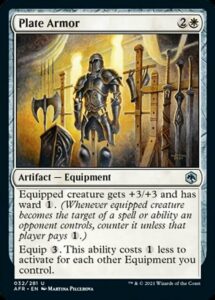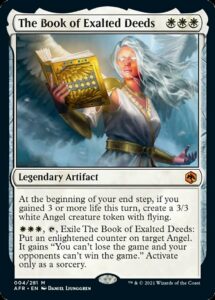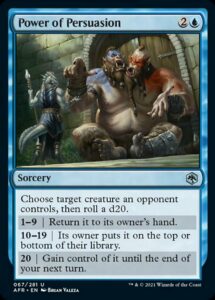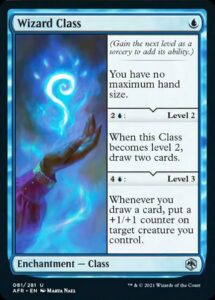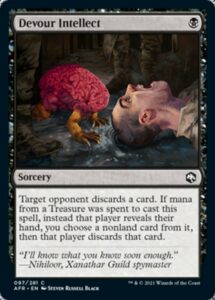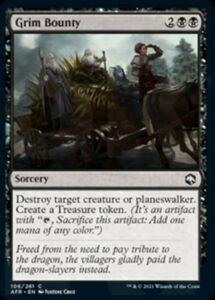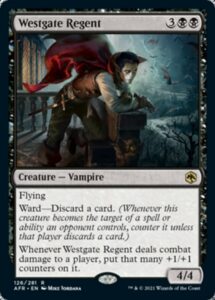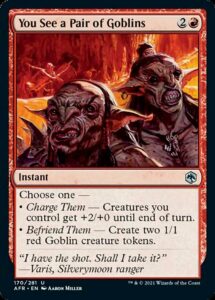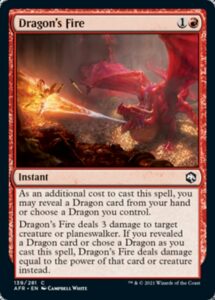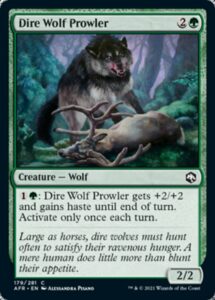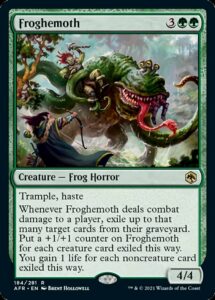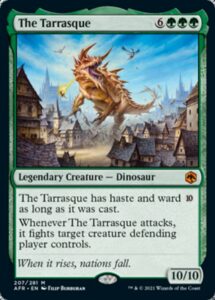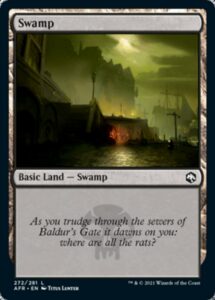Adventures in the Forgotten Realms is finally out! For many of us, this was the first prerelease weekend where we could safely congregate and sling cardboard. And oh boy, getting to play some outdoor AFR at my local game store was a reminder of just how much fun Magic can be. I love getting to ease someone in to their first Magic event, helping people build or rebuild their Sealed decks (a gift I was given back in 2010 that I am forever grateful for), and feeling actual, physical cards in my hand.
That said, this wasn’t my first rodeo with AFR. It’s been out for almost two weeks on Magic Arena. I was on vacation when it came out, so I’m well past twenty drafts and have likely played more of it already than I ever will. So today, I’d like to dive in to the designs of the set. What’s worked, what hasn’t worked as well, and what it suggests about the state of contemporary Magic design.
Red-white equipment is a theme we’ve seen a few times over the years, but it’s generally never been quite good enough. It’s a hard theme to enable—an A+B strategy where you need to obtain sufficient quantities of both effects, draw both in a game, and have the payoff justify the investment. With effects like Constellation that give you the benefit immediately or like tribal where you’ve got two creatures on board, equipment is even slower to get off the ground, since it’s an inanimate object that requires additional mana to do anything. In AFR, I think they finally cracked the code, and they did it without Living Weapon or snap-on equipment (okay, except for Goblin Morningstar and Dueling Rapier).
Plate Armor is a fantastic tweak to Vulshok Battlegear. As a white artifact, it’s allowed to be a bit stronger than a colorless artifact (though Vulshok Battleground was definitely pushing it in terms of Limited power). The addition of Ward 1 doesn’t look like much, but it’s surprisingly effective at slowing down your opponent’s ability to disrupt your build-a-big-creature engine. And the mana discount ability is kind of brilliant. It’s hugely powerful (as mana discounts are), but the cost is both steep and works with the theme—play lots of equipment, even though it’s normally a bad idea. Altogether, the design works really well.
Recently emergency banned in Standard 2022, The Book of Exalted Deeds is an odd design. We’ve seen plenty of “gain life, make tokens at the end step” cards, but 3/3 white Angel creature tokens have only ever been made by one card: Linvala, the Preserver. I understand that there’s mathematical elegance to a three mana artifact with a three mana activated ability that converts three life into a 3/3, to say nothing of the fact that 4 life for 4/4 angels might be too weak or too strong, but it’s odd seeing smaller angel tokens. And the activated ability, while a thematic thing for the most powerful holy book to grant to an angel, is definitely hard to balance in a format with noncreature angels like Faceless Haven.
Power of Persuasion is my least favorite design in AFR. It tells an incredible story—you can temporarily send the guard to the other room before they come to their senses, you can be a bit more successful and send them home (possibly forever, if they get tucked), or if you really succeed, they’ll jump onto your side before the magic fades. It hits the d20 moment where you sometimes succeed too well and create a new problem for yourself.
However, a good story doesn’t justify poor gameplay. As with a couple die rolling cards, there’s a massive power differential between the low and high roll results (one puts you down a card, the other is card advantage neutral). I’ll grant that I prefer the designs which scale up one effect, but all d20 cards shouldn’t follow the same paradigm (and Unsummon can’t be upscaled cleanly). That said, the twenty result is a different effect entirely! Moreover, it’s likely to be the worst possible result! Unless you have a sacrifice outlet, this is the only mode that doesn’t force your opponent to recast the spell. It might seem excessive to get this worked up over a mediocre uncommon, but this feels like a Magic card that’s meant to be read, not played with.
On the completely other side of the spectrum, I adore the classes, especially Wizard Class. The saga card frame helps them look distinct from other cards. The little arrows in the level borders subtly communicate that these effects are additive, not replacements (as level up was). They fit perfectly within the world of D&D where choosing a class is among the most consequential early decisions a player makes. And they play well!
Sure, some are stronger than others (Ranger Class), but they all create flexible strategies around them. Wizard Class is my favorite not only because I love drawing cards, but because it’s a blue card that pushes the game towards a conclusion in combat rather than burying your opponent beneath card draw.
And in case you think it’s my favorite because Wizard was my favorite class to play, you’d be wrong. My favorites are Barbarian and Bard. Never played a Bardbarian, but I might give it a try sometime.
This is a nifty innovation! True, we just saw snow mana-matters in Kaldheim, but this is nevertheless a cool new tool to make treasure even more interesting to use. Instead of using it to ramp out an early threat or fix your mana, your treasure can be used to power up a spell. Devour Intellect isn’t powerful, but the promise of upgrading it into a painless Thoughtseize is tantalizing, and it makes me wonder what other designs in this vein we could see down the line.
Just remember that if your opponent is down to one card, never sacrifice the treasure.
We’ve come a long one way from Contract Killing. It provided mana too late to matter, and cost too much to profitably kill anything. Grim Bounty feels like the perfect strong, but not bonkers common removal spell for today. For four mana, you kill anything and get a little something extra for your trouble. That’s about right given that most formats have powerful (and hard to block) two and three mana creatures.
I appreciate that post-War of the Spark, most removal spells interact with Planeswalkers as well as creatures. It’s still easy to forget, given that this is only a recent development and it’s rare to be able to see an opposing Planeswalker; but I wonder if two years from now, we’ll be surprised when something doesn’t hit planeswalkers rather than forget that it can.
Westgate Regent is both a painfully fair bomb and a new kind of frustrating. It’s the first creature to have a Ward cost that’s neither life loss nor mana, and man is that powerful. Makes one wonder what other kinds of Ward we’ll see in the future. Sacrifice a creature? Mill 10? They draw a card? There’re a lot of possibilities, though I think I’d like a bit more time to get used to Ward before its boundaries are pushed again.
I know I was down on Power of Persuasion for using a story to justify a card, but this is both a wonderful little story and it plays well. I think I might have to wait until the next Un-set before I see a short line of text as charming as Befriend Them. Just a great design all around.
Dragon’s Fire is an excellent reminder of Magic’s linguistic restrictions and the wordiness now allowed at common. At its core, Dragon’s Fire is a simple effect bolstered by a clear story: either you cast some 3 damage dragonfire or you get one of your dragons to breathe the real stuff.
Magic is a physical game as well as a digital game, and physical games (especially ones played competitively) can’t be ambiguous about how they function. Furthermore, Magic isn’t a board game where you crack open the rulebook to read further—the cards must explain themselves. That’s why Magic cards are written according to strict, wordy templates.
If Magic were a purely digital game, cards could be more casually worded and ambiguous, like, “Choose: Deal 3 or strike with a dragon ally.” It might not be entirely clear how it works, but the game’s rule engine and UI will help you understand it and ensure you cast it correctly. Or, if it were a board game, you’d have a rulebook to reference (and the cards wouldn’t have to function alongside twenty thousand other game pieces). Instead, we’ve got this mammoth nine lines of text in small print, something we’d almost never see at common this side of Ice Age.
It’s always nice seeing a twist on a classic design. Magic has had many Rootwallas over the year, some stronger than others, but almost all were just shifting around numbers. The addition of haste on Dire Wolf Prowler won’t be relevant much of the time, but allowing this to sometimes be a 4/4 Haste for five is a nice new bonus for a Rootwalla.
Speaking of five mana 4/4 Hastes, I love Froghemoth. It’s a silly concept that plays beautifully, since it needs your opponent to cooperate for it to shine. If you accelerate it out on turn four off a treasure, your opponent has to answer it, but it’s going to stay a 4/4. I appreciate that it’s solid on its own but is only busted good at later stages of the game.
The fact that it’s late game incidental graveyard hate is another plus—cheap and strong cards like Deathrite Shaman and Scavenging Ooze can push graveyard strategies out entirely, while expensive cards like our Frog Horror friend give you game without pushing them out of the format entirely.
I haven’t played D&D in years, but I’ve fought a Tarrasque. For fun, I built my original barbarian into a level twenty character, sat down with my friend Sam, and saw what my blatantly overpowered hero could do against this blatantly overpowered foe. While the fight wasn’t the most memorable (big numbers are big), I’ve always had a fondness for The Tarrasque.
This feels like a substantial let-down. The Tarrasque is one of the only D&D elements in AFR I have a personal connection with (I’ve never played modules like The Tomb of Horrors or read books about Drizzt), but this doesn’t feel like the epic monster the Tarrasque is supposed to be. It feels generic. I don’t know what I would have been satisfied by, but I’d have expected something more exciting given that it has an anti-reanimation, anti-sneaking clause.
Frankly, my favorite aspect of the design is the name. By adding “The” into the name, it’s clear that this is a legendary creature (a lesson almost certainly learned from Questing Beast).
To close things out, we’ve got an innovation in basic lands! Now, these aren’t for me—I’m very much a lover of full art lands. But I love these story snippets! As a former GM and roleplayer, moments like these take me back. And I know that for some people, these basics are exactly what they’ve been waiting for.
I love that Magic is a big enough game that even things as simple as basic lands have so much opportunity for self-expression. For years, it was only about art. Then, it was about art and borders. Now, people can also customize their lands for the stories they tell (okay, and they can also use the silly all-text Secret Lair lands). Little things like this make me excited for all the little ways Magic can remix and iterate on what it’s been doing for almost thirty years just as much as huge mechanical innovations and new worlds excite me.
Overall, I’m pleased with the design of Adventures in the Forgotten Realms. The Limited format isn’t my cup of tea and I have no emotional connection to the Forgotten Realms, but I’m nevertheless happy with it despite all the references I know I’m not getting. And for a set designed for fairly different audiences than yours truly, that reflects quite well on the teams that made AFR happen.
Zachary Barash is a New York City-based game designer and the commissioner of Team Draft League. He designs for Kingdom Death: Monster, has a Game Design MFA from the NYU Game Center, and does freelance game design. When the stars align, he streams Magic (but the stars align way less often than he’d like).

